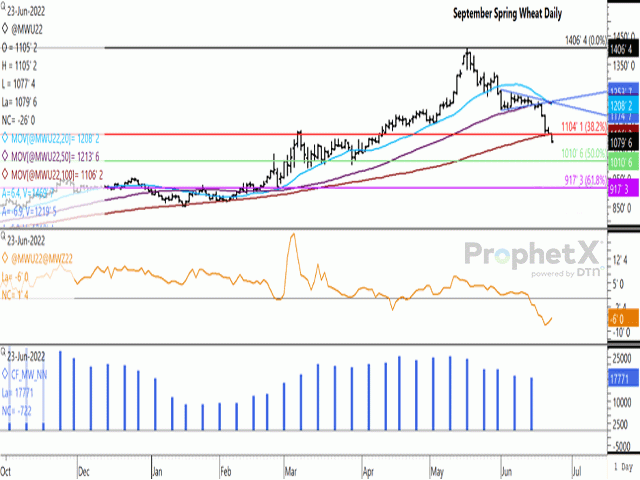Canada Markets
Weak Technical Signals Seen in September HRS
Technical traders are in control this week, although the September MGEX hard red spring contract trailed both Kansas City hard red spring wheat and Chicago soft red winter wheat in breaching support this week.
The September HRS contract closed 26 cents lower at $10.79 3/4 per bushel on Thursday, a fourth consecutive lower close. This move resulted in a close below the contract's 100-day moving average of $11.06 1/4/bu, the first close below the 100-day moving average since Jan. 14, while only the second time over the life of the contract.
The $11/bu level may have been viewed as potential psychological support, although Thursday's close ended below this level for the first time since April 7.
P[L1] D[0x0] M[300x250] OOP[F] ADUNIT[] T[]
In addition, Thursday's move resulted in a close below the 38.2% retracement of the move from the contract low to the contract high of $14.06 3/4/bu reached on April 17, shown as the red, horizontal line on the attached chart at $11.04/bu. Should this move below support hold, retracement theory would indicate the potential for a continued move to the 50% retracement level of $10.10 3/4/bu.
The blue bars of the histogram on the lower study show the trend in the noncommercial net-long position, having fallen for five consecutive weeks, with the latest report showing a net-long position of 17,771 contracts as of June 14. The next report, possibly due for release on June 24, should show yet another week of liquidation by speculative traders.
At the same time, the spring wheat market is viewed as a neutral market overall, with ongoing supportive fundamental data. Earlier in the week, USDA viewed the U.S. spring wheat crop at 59% good-to-excellent, which DTN analysis points to the fourth-lowest rating for this week in the past 20 years. In addition, as of June 20, the Saskatchewan Crop Report estimates 55% of the spring cereals are at normal growth stages, down from 81% this time last year and the five-year average of 67.4%, while tied for the lowest percentage seen in the past eight years.
As indicated by the line in the middle study, the Sept/Dec futures spread has narrowed by 2 cents over the past two sessions to minus 6 1/4 cents (December over the September), a less-bearish approach to trade, likely on the part of commercial traders, which bears watching.
Cliff Jamieson can be reached at cliff.jamieson@dtn.com
Follow him on Twitter @Cliff Jamieson
(c) Copyright 2022 DTN, LLC. All rights reserved.






Comments
To comment, please Log In or Join our Community .